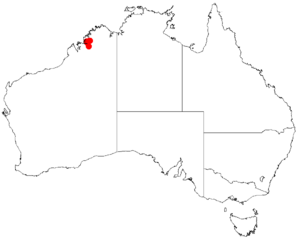Kimberley cluster wattle facts for kids
Quick facts for kids Kimberley cluster wattle |
|
|---|---|
| Scientific classification | |
| Genus: |
Acacia
|
| Species: |
phacelia
|
 |
|
| Where it grows in Australia | |
Acacia phacelia, also known as the Kimberley cluster wattle, is a type of shrub. It belongs to the Acacia family, which is a large group of plants. This special wattle only grows in a small part of north-western Australia. It is found nowhere else in the world!
What Does the Kimberley Cluster Wattle Look Like?
This shrub usually grows to be about 0.4 to 1.0 meter tall. Sometimes, it can even reach 1.5 meters high. It tends to spread out and can look a bit messy. Its thin branches are covered in soft, fine hairs.
Like most Acacia plants, it doesn't have regular leaves. Instead, it has special flattened stems called phyllodes. These phyllodes act like leaves. They grow in groups of two to eight on older parts of the plant. On new shoots, they grow one by one.
The phyllodes are flat and stay green all year. They are narrow and shaped like a long oval. They are usually 6 to 10 millimeters long and 0.7 to 1.3 millimeters wide.
The Kimberley cluster wattle blooms at different times of the year. You can see its flowers from December to January and again from May to October. The flowers grow in small, oval or short-cylinder shapes. These flower spikes are usually 3 to 8 millimeters long.
After the flowers, the plant grows seed pods. These pods are firm, flat, and straight. They are reddish-brown and have lines running along them. The pods are 3 to 8 centimeters long and 2 to 4 millimeters wide. Inside, you'll find grey-brown to dark brown seeds. Each seed is about 4 to 4.5 millimeters long and has a dull cream border.
Where Does the Kimberley Cluster Wattle Grow?
This unique plant is found only in a small area of the west Kimberley region. This region is in Western Australia. Only a few groups of these plants are known to exist.
These groups are spread out over about 100 kilometers. You can find them near places like the Sale River, Synnott Range, Edkins Range, and Mount Daglish. The Kimberley cluster wattle often grows between sandstone ridges. It prefers shallow, sandy soils. It is usually found in open, low woodland areas, but it is not very common there.

